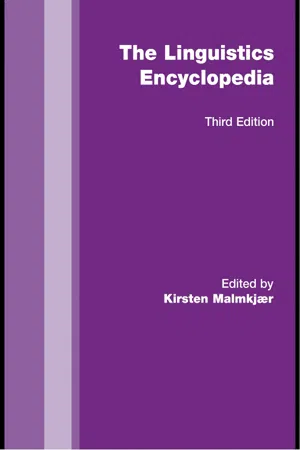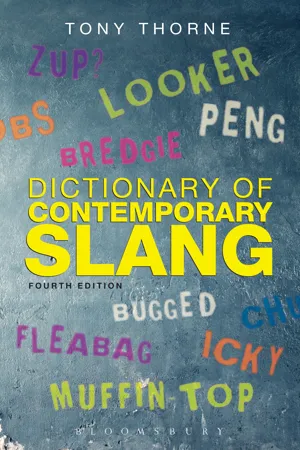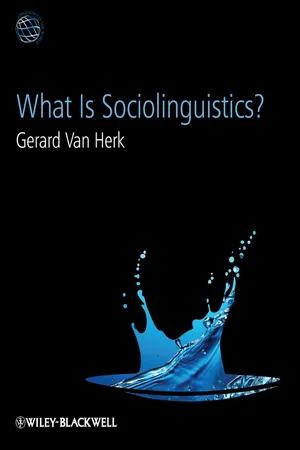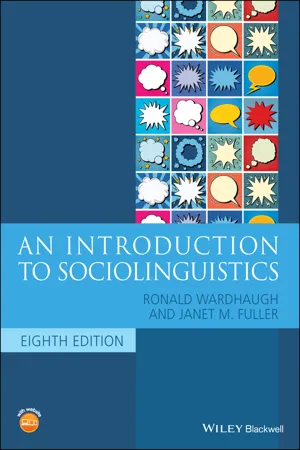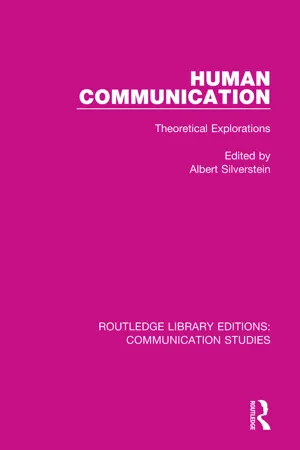Languages & Linguistics
Slang
Slang refers to informal, non-standard words and expressions that are commonly used within specific social groups or subcultures. It often evolves from existing language and reflects the changing attitudes and behaviors of a particular community. Slang can be dynamic and transient, with new terms constantly emerging and existing ones falling out of use.
Written by Perlego with AI-assistance
Related key terms
1 of 5
7 Key excerpts on "Slang"
- eBook - ePub
- Kirsten Malmkjaer(Author)
- 2009(Publication Date)
- Routledge(Publisher)
Probably, although not provably, a universal feature of human languages (examples that follow are drawn from English, particularly British English), ‘Slang’ is a label familiar to the public, which has been problematised or avoided by some academic linguists. We should remember that ‘neither the social nor the linguistic meaning of Slang is fixed and determinate, and what counts as Slang … is itself negotiated in discourse’ (Bucholtz 2001). Lexicographers treat Slang as a category in its own right, collect examples and offer definitions and etymologies but rarely analyse its usage or the socio-cultural practices of which it is a component. What a non-specialist hearer deems to be Slang will depend upon a range of variables such as age, frequentation, exposure to variant vernaculars, literacy, etc.One useful way of characterising Slang is as a style of language occupying, along with intimacies such as ‘baby talk’ and terms of endearment, the extreme ‘informal’ position on a continuum representing degrees of formality. Slang is coined, adopted and used, and evolves separately from or in deliberate contrast to what are thought to be the standard and prestige varieties of a language. It may differ from supposed norms in terms of syntax and phonology (non-specialists often characterise unfamiliar variants, such as ethnically marked speech, or regional dialect as Slang) but is most noticeably a specialised lexicon or vocabulary. Slang is often therefore viewed as primarily ‘lexical’, where lexis extends beyond the word to take in compounds, phrases, slogans and other prefabricated units or chunks of language up to sentence level (‘Who’s eaten all the pies?’ said in the presence of an obese person; ‘Get a room!’, an admonition to those engaged in a ‘PDA’ or public display of affection). Slang generally originates within small self-defined communities of practice or communities of circumstance – otherwise known as cliques, gangs, friendship groups or peer groups, micro-niches, micro-cultures or (larger) subcultures – where it is used to rename aspects of shared experience and environment or to name aspects not hitherto describable. Some Slang terms may emerge from the small in-group to be taken up by a cohort of contemporaries, may then be adopted by larger speech communities for more widespread, still highly informal usage (‘cool’ in global Englishes, for example), while a few cross over into mainstream use and lose their idiosyncratic associations (‘rogue’, ‘mob’ and ‘bus’ began as Slang). Chapman (1986: xii) refers to primary and secondary - eBook - PDF
- Tony Thorne(Author)
- 2014(Publication Date)
In emphasising its democratic credentials he's right, but although it does make use of poetry's rhetorical tricks (and more devices besides), poetry is allusive while Slang is anything but, depending for its power on either complete, shared understanding (by insiders) or complete bafflement (on the part of outsiders). Slang is also by definition used particularly to talk about transgressive behaviour and about activities which speakers either want to keep secret or for which there may not be an adequate vocabulary in standard language. Slang is not only used for communication purposes – to exchange data – but for social purposes to reinforce relationships: solidarity, belonging, membership of an in-group, and to exclude outsiders. This means that sometimes it is used in different ways from normal language – words and phrases may be repeated, chanted, used ungrammatically or used like slogans, for example. This can seem alien and suggest – wrongly – that the language is crude, impoverished or deficient. So nonstandard language such as Slang or youth-identified vernacular is certainly part of a repertoire of performance, a pattern of behaviour which can include rebelliousness, anti-social attitudes, educational failure and even violence, crime and prejudice. It also plays an important part, though, in bonding, belonging, play and pleasure, and in constructing and negotiating individual and group identities. More specifically, Slang terms have certain recognisable functions. Firstly, like any new coinage, a Slang word may fill a gap in the existing lexicon. For example, there is no single verb in standard English that defines the cancelling of a romantic tryst or social arrangement, so British adolescents adopted the words ding or dingo . To jump up and hug someone suddenly from behind is rendered much more succinct in US campus speech as the single word glomp . - eBook - ePub
- Gerard Van Herk(Author)
- 2012(Publication Date)
- Wiley-Blackwell(Publisher)
And sometimes, languages are “invisible.” Kachru and Bhatia (1978) describe a situation in parts of India where the local variety (distinct enough for linguists to consider it as a separate language) might not be considered a language at all. So when census takers come around and ask people what language they speak, people instead name the language that they occasionally use in formal situations: Hindi. This was especially true just after Indian independence, when nationalist feeling was at its strongest; in that census, reported Hindi use spiked.Other naming issues: Dialect, Slang, accent, variety …This might be a good place to clear up a couple of other naming problems related to dialects. Non-linguists often call non-standard varieties Slang . To us linguists, however, “Slang” refers only to words – either words that are new to the language, or old words or phrases with new meanings. Slang is usually associated with younger speakers – in fact, a good indicator that a Slang term is finished is when middle-aged university professors like me start using it. Most Slang is “faddish” or short-lived – you don’t hear many people saying far out or the bee’s knees any more, and if I put any current Slang in the book, it’ll be outdated by the time you read it. Not all Slang dies out, though. Mob , freshman , and glib all started out as Slang, but have become part of the standard language, and only a generation ago mainstream news media used to give a definition whenever they used the then-obscure Slang term ripoff . Unlike Slang, a dialect is usually distinct in multiple linguistic domains – lexicon (word choice), morphology (word structure), syntax (sentence structure), and phonology/phonetics (pronunciation).A second term sometimes used by non-linguists to describe dialects is accent - eBook - PDF
- Ronald Wardhaugh, Janet M. Fuller(Authors)
- 2021(Publication Date)
- Wiley-Blackwell(Publisher)
Languages, Communities, and Contexts Part I An Introduction to Sociolinguistics, Eighth Edition. Ronald Wardhaugh and Janet M. Fuller. © 2021 John Wiley & Sons Ltd. Published 2021 by John Wiley & Sons Ltd. Companion website: www.wiley.com/go/wardhaugh8e 2 We stated in the introductory chapter that the concept of language is considered by many sociolinguists to be an ideological construct. Further, we noted that all languages exhibit internal variation, that is, each language exists in a number of varieties and is in one sense the sum of those varieties. We use the term variety as a general term for a way of speaking; this may be something as broad as Standard English, or a variety defined in terms of loca- tion and social class (e.g., ‘working-class New York City speech’), or something defined by its function or where it is used, such as ‘legalese.’ In the following sections, we will explore these different ways of specifying language varieties and how we define the terms ‘lan- guage’ and ‘dialect’ (regional and social). We will also address how the associations between language and social meaning develop and are used in communicating in different speech contexts. What is a Language? What do we mean when we refer to a language or, even more important, the idea of mixing languages? As we will discuss further in chapters 8 and 9, recent research has coined many new terms to describe what has traditionally been called multilingualism – ‘(trans)lan- guaging,’ ‘metrolingualism,’ ‘heteroglossia.’ These terms reflect the idea that languages are ideological constructs; while we (usually) have names for different ways of speaking and can describe their features, in practice linguistic boundaries may be fluid. - eBook - ePub
Slang
To-Day and Yesterday
- Eric Partridge(Author)
- 2015(Publication Date)
- Routledge(Publisher)
Common Words of the language. But they are linked on every side with words that are less and less entitled to this appellation, and which pertain ever more and more distinctly to the domain of local dialect, of the Slang and cant of ' sets ' and classes, of the popular technicalities of trades and processes, of the scientific terminology common to all civilized nations, of the actual languages of other lands and peoples." Then comes the sentence with which a mere mortal like myself delights to buttress his pusillanimity: " And there is absolutely no defining line in any direction: the circle of the English language has a well-defined centre but no discernible circumference." He illustrates his thesis with a diagram, which for very shame I have forborne to ask permission to reproduce; but his comment on that diagram is itself diagrammatic in its divine clarity. " The centre is occupied by the ' common ' words, in which literary and colloquial usage meet. ' Scientific ' and ' foreign ' words enter the common language mainly through literature: ' Slang ' words ascend through colloquial use; the ' technical' terms of crafts and processes, and the ' dialect ' words, blend with the common language both in speech and literature. Slang also touches on one side the technical terminology of trades and occupations, as in ' nautical Slang', ' Public School Slang', ' the Slang of the Stock Exchange ', and on another passes into true dialect. Dialects similarly pass into foreign languages [and into Slang, colloquial, and literary use]. Scientific terminology passes on one side into purely foreign words, on another it blends with the technical vocabulary of art andmanufactures. It is not possible to fix the point at which the " English Language ' stops, along any of these diverging lines." In the language of current flippancy, a flippancy common to both Slangy and colloquial speech, I cannot refrain from murmuring " Thank you, Sir James, for those few kind words ". It is pleasant to find oneself on the side of the angels, which is not quite the same as fighting with the big battalions.1 On p. xvii of vol. 1 of The Oxford English Dictionary, 1888.2 Sir James used colloquial to mean " employed in normal speech".Dialect," says Mr. H. W. Fowler in his perspicacious and penetrating, percipient and perspicuous Modern English Usage, " is essentially local; a dialect is the 1 variety of a language that prevails in a district, with local peculiarities of vocabulary, pronunciation, and phrase."1 The sentence, pace this authority (whose work I admire), would be less ambiguous if it were written thus: " a dialect is that variety of a language which prevails in a district and has local peculiarities," etc.Those peculiarities are constantly being incorporated into general colloquial speech as into Slang, especially if they are picturesque. At ordinary times, the incorporation is slow and inconsiderable, but on special occasions, as during a war (when countrymen mingle at close quarters with townsmen), numerous dialectal terms become part of the common stock and some few of them pass into formal speech and into the language of literature, whether prose or poetry. Writing in 1902, Greenough and Kittredge remark that " when Sir Thomas Lipton spoke of ' lifting the cup he was merely using a provincialism [cf. ' to lift cattle and shoplifter', they say in a footnote], but when the people of the United States took up the expression in good-natured mockery, it became Slang. Burn's croon - eBook - ePub
Human Communication
Theoretical Explorations
- Albert Silverstein(Author)
- 2015(Publication Date)
- Routledge(Publisher)
The function of Slang in establishing local identity has been observed for many years. Its chief function seems to be identifying group membership. In any case, we find that groups resent the adoption of their own vocabulary by others; if they cannot prevent it, they will shift to other forms that are still their own.The adolescent group known as the Cobras in south Harlem always used the term tip to mean "go," as in Let's tip. We had heard Let's tip hundreds of times, and there was no doubt about its appropriate meaning and use. But when I used it one day on an outing with the Cobras, there was an immediate surge of amusement from the members and they pretended not to understand. Outsiders are allowed and encouraged to shift on some points of phonology and grammar, but there was a sharp reaction against anyone else wearing this linguistic mark of local identity.Slang is one of the most conspicuous forms of linguistic innovation; most linguistic change operates well below the level of consciousness. Young people know that their Slang is different from their parents; but they seldom realize that their sound pattern or their grammar has changed. So don't I has risen to the level of an overt stereotype in eastern New England. Teachers consider it to be one of the many mistakes in grammar that young people make because they do not know better. But as far as young people are concerned, it seems to function as one of the marks of local identity, a symbol of resistance to the standardizing influence of the teachers who would erase those marks if they possibly could.Intimacy
Vocabulary is fairly accessible to inspection; sound changes are more difficult to observe, and grammar even more so; but perhaps the most elusive of all linguistic changes are systematic shifts in the rules of discourse. When we are engaged in social interaction with another speaker, at the beginning or ends of our conversations, we are in a structural situation that makes it almost impossible to know exactly what we are saying or doing.A good example of such a structural situation is leave-taking. For several years, I have been observing these forms: first, taking notes on what speakers actually say; second, asking speakers what they say. There is little connection between the two. - eBook - ePub
Japanese–English Translation
An Advanced Guide
- Judy Wakabayashi(Author)
- 2020(Publication Date)
- Routledge(Publisher)
Iwannadrink (Birnbaum 2002: 295).Like writers, translators have their own idiolect. A predilection for certain turns of phrase can result in a ‘translator’s tic’. Ways of overcoming this include paying careful attention to one’s writing, soliciting critical feedback, and consciously looking for alternative expressions when reading other people’s work.Exercises
1 Work through a Japanese text of your choice to pick out any idiolectal features, and then consider whether these are significant enough to need conveying in translation, and if so, how.2 Examine an extended piece of your own writing or one of your translations and see if you can identify any mannerisms.Slang and swearing
Mattiello (2009: 67) defines Slang asa highly informal, quite temporary, debased, unconventional vocabulary which is often associated to a social group or to some specific subject. It is described as fresh and novel, often colourful, faddish, playful and humorous, and aims either at establishing a social identity for the speaker or at making a strong impression upon the hearer.She identifies a range of speaker-oriented properties of Slang (group-restriction, informality, time-restriction, subject-restriction, obscenity, vulgarity, unconventionality, localism, secrecy, privacy), hearer-oriented properties (playfulness, freshness, novelty, faddishness, humour, strong impression, offensiveness, colourfulness, musicality, aggressiveness) and intrinsic properties (extra-grammatical morphology, semantic indeterminacy).The first task is to recognise that a Japanese expression is Slang. The next challenge is to find an emotionally charged match in English, keeping in mind the possibility of cultural differences relating to the offensiveness of specific terms. Mattiello (2009: 83) recommends considering (a) who the speaker is; (b) what are the desired effects on hearers and (c) what morphological or semantic devices are used to achieve this in the source language.
Index pages curate the most relevant extracts from our library of academic textbooks. They’ve been created using an in-house natural language model (NLM), each adding context and meaning to key research topics.
